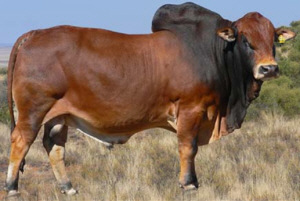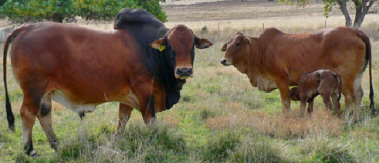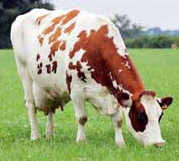



Boran
History
The Boran developed in eastern Africa, more specifically the Borana plateau in southern Ethiopia. This area was where all the different breeds migrated through to their various destinations in Africa. The Boran developed into the dominant breed of eastern Africa and especially in Kenya, where the Kenyan Boran Cattle Breeders' Society (BCBS) have bred the "Improved Boran" since the turn of the century.As far as can be determined this is the only breed in Africa to have this specific combination of genes.
 Photo courtesy of Clynton Collett Group, www.clynton.collettgroup.com |
The Boran is a breed that had its last infusion of 'new' genes in 700 AD. The Boran is therefore not a synthetic or compound breed that have been crossbred in the last few decades. It has been bred as a pure breed for 1300 years. The importance of this to the commercial breeder is that the Boran will have much stronger hybrid vigour than modern compound breeds.
Today Boran breeders have greatly improved the beef conformation of their animals, but they have never lost sight of the important qualities of the indigenous Boran.
Characteristics
The Boran is medium in size with a short head, small ears, loose dewlap and a large hump above the shoulders. They can be horned or polled. They vary in height from 114cm to 147cm tall, and in weight bulls weigh approximately 500kg to 850kg. Cows weigh about 380kg to 450kg Their skin is loose, thick and extremely pliable for added insect repellence plus it is dark pigmented with fine short hair for heat tolerance. Hair colour can be a range of colours except brindle or solid black.The Boran male and female share breed points, the sexes, however, show marked dimorphism - the female being notably small, whilst the male grows to a large size.
The cow has a well-carried udder with strong attachments and neat, small teats, in contrast to some Asian Zebu breeds. Boran heifers reach puberty at an average age of 385 days. She is an excellent mother, not only will she feed her calf so well that high weaning weights are attainable, but she guards against predators, and will never allow her calf to get lost in the bush. Calving problems hardly exist. Calves at birth weigh an average of 28 kg for males and females, 25 kg.
Boran cattle have developed adaptive traits of crucial importance for their survival. Some of these characters are - the ability to withstand periodic shortage of water and feed, ability to walk long distances in search of water and feed and ability to digest low quality feeds. The herd instinct of the Boran makes it easy to manage and survive in bush country. They will always stay together and can 'graze on the trot'.
The well-developed beef conformation shows up in carcase appraisals. The depth of eye muscle, marbling, even fat cover and ratio of hind to forequarter make the Boran difficult to beat, hence the preference of Kenya butchers for young, well-finished Boran steers.
Statistics
 Photo courtesy of Clynton Collett Group, www.clynton.collettgroup.com |
Comparative
Carcass QualityTrials in Nebraska, U.S.A, shows that the Boran and its crosses score consistently better than other Zebu Breeds for meat tenderness, carcass marbling and rib eye area.
www.studbook.co.za/Society/Boran
"Animals with Boran genes have a relatively low maintenance requirement. This was substantiated in a recent study at the US Meat Animal Research Centre in Nebraska". (Haile-Mariam, Sprinkle et al. 1998)
"…young Boran animals can make dramatic recoveries after drought years when pasture conditions improve" (Coppock, 1994)
Average weight gains per day on grass & feedlot: -
Grass = 0.7 kg - 1.0 kg per day depending on grass quality Feedlot = 1.3 kg per day depending on type of cross used (this was found at a recent trial at Marania Farm - Timau where using Boran cross Angus steers & heifers)
Milk Production from Boran / Friesian F1: -
1st Lactation : -
 Photo courtesy of Clynton Collett Group, www.clynton.collettgroup.com |
High= 13.8 kg per day
2nd Lactation : -
Av= 10.4 kg per day
High = 15.6kg per day
3rd Lactation : -
Av= 13.4 kg per day
High = 19.5 kg per day
www.borankenya.org
Distribution
Today the Boran is now found in Kenya, Zambia, Tanzania, Uganda, Zimbawe, South Africa, Australia and the USA.References (the above information was cited from the following sites)
www.studbook.co.za/Society/Boran
www.borankenya.org
www.clynton.collettgroup.com


